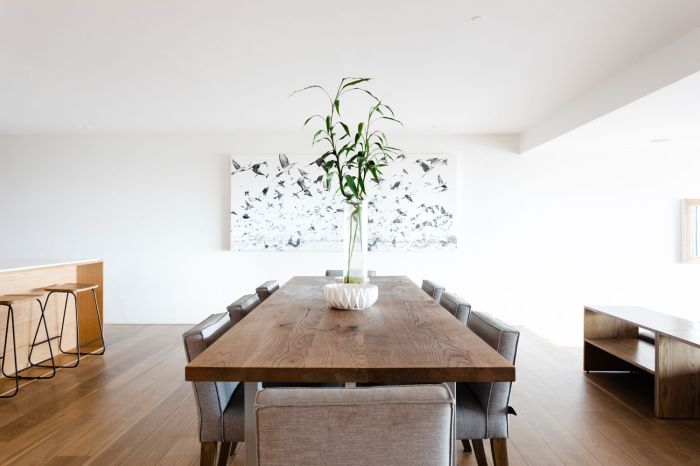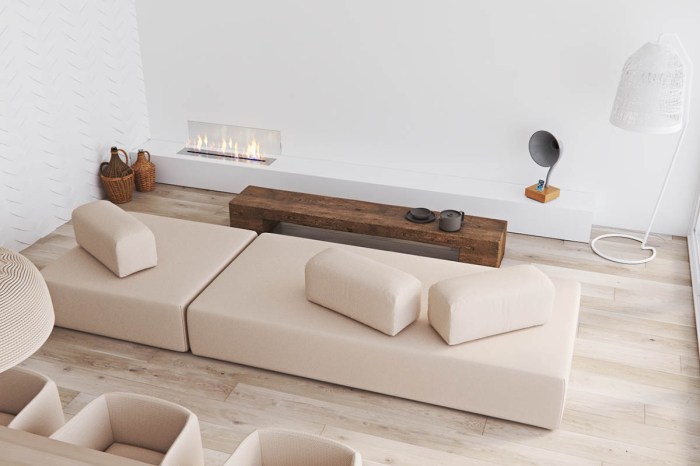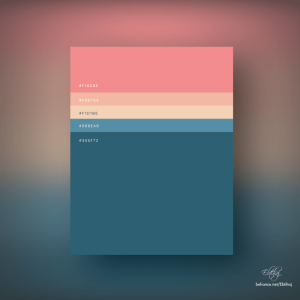
Embark on a journey into the realm of Sustainable Minimalist Design where sustainability meets minimalism to create a harmonious blend of functionality and aesthetics. Explore the essence of this innovative design approach that is shaping the future of modern living.
Discover how the fusion of sustainable practices and minimalist principles is revolutionizing the way we perceive and interact with our living spaces.
Sustainable Minimalist Design
Sustainable minimalist design is a concept that focuses on creating aesthetically pleasing and functional designs while minimizing environmental impact. It involves using fewer resources, reducing waste, and prioritizing sustainability throughout the design process.
Examples of Sustainable Materials in Minimalist Design
- Bamboo: A fast-growing and renewable resource that can be used for furniture, flooring, and decor.
- Recycled Glass: Glass can be recycled repeatedly without losing quality, making it a sustainable choice for lighting fixtures and decorative items.
- Reclaimed Wood: Salvaged wood from old buildings or furniture can be repurposed for new minimalist designs, reducing the need for new wood resources.
- Organic Cotton: Sustainable cotton farming practices minimize chemical use and water consumption, making it an eco-friendly choice for textiles in minimalist design.
The Importance of Sustainability in Modern Design Trends
In today’s world, where environmental concerns are at the forefront, sustainability has become a key consideration in design trends. Embracing sustainable practices not only helps reduce the negative impact on the planet but also reflects a commitment to ethical and responsible design. By incorporating sustainable materials and practices into minimalist design, designers can create timeless pieces that contribute to a more eco-friendly and conscious lifestyle.
Minimalist Design

Minimalist design principles focus on simplicity, functionality, and the use of clean lines. This design aesthetic aims to strip away unnecessary elements, focusing on the essentials to create a sense of calm and tranquility in a space.
Influence on Interior Design
Minimalism greatly influences interior design by promoting a clutter-free and organized space. It emphasizes the use of neutral colors, simple furniture pieces, and a lack of excess decorations. This approach creates a serene environment that enhances relaxation and promotes mindfulness.
- Avoid clutter: Keep surfaces clear of unnecessary items to maintain a clean and streamlined look.
- Choose quality over quantity: Invest in well-made, durable pieces that serve a purpose and add value to the space.
- Embrace negative space: Allow for breathing room in your design by leaving areas of empty space to create balance and harmony.
- Use a neutral color palette: Opt for soft hues like white, beige, or gray to create a sense of openness and lightness.
- Focus on functionality: Select furniture and decor items that serve a practical purpose while still contributing to the overall aesthetic.
Modern Classics

When it comes to design, modern classics are pieces that have stood the test of time and remain relevant and stylish despite changing trends. These pieces are timeless and are often considered iconic in the world of interior design.
Key Characteristics of Modern Classic Furniture
Modern classic furniture typically exhibits the following key characteristics:
- Simple and clean lines: Modern classics often feature sleek and minimalistic designs that emphasize simplicity.
- High-quality materials: These pieces are crafted from high-quality materials that are durable and long-lasting.
- Timeless appeal: Modern classic furniture has a timeless quality that allows it to blend seamlessly with various design styles and aesthetics.
- Iconic design elements: These pieces often feature iconic design elements that make them instantly recognizable and highly sought after.
Timeless Appeal of Modern Classics in Interior Design
Modern classics hold a timeless appeal in interior design because they bring a sense of sophistication, elegance, and history to any space. These pieces are versatile and can be easily incorporated into both modern and traditional design schemes, adding a touch of class and style. Additionally, modern classics often serve as focal points in a room, drawing the eye and adding visual interest to the space.
Modern Living
Modern living in the context of interior design focuses on creating spaces that are sleek, minimalistic, and functional. It emphasizes clean lines, open layouts, and the use of technology to enhance daily life.
Comparison with Traditional Living Spaces
Traditional living spaces tend to be more ornate, with heavy furniture and intricate details. Modern living spaces, on the other hand, prioritize simplicity and practicality. They often feature multifunctional furniture and smart storage solutions to maximize space.
Promotion of Functionality and Efficiency
- Open Floor Plans: Modern living spaces often have open layouts that create a sense of spaciousness and flow.
- Minimalist Design: By keeping decor and furniture to a minimum, modern living spaces promote a clutter-free environment that is easy to maintain.
- Smart Home Technology: Integration of smart devices and systems allows for efficient control of lighting, temperature, and security.
- Sustainable Materials: Many modern living spaces utilize eco-friendly materials and practices to reduce environmental impact.
In conclusion, Sustainable Minimalist Design offers a transformative perspective on design, emphasizing the significance of sustainable practices while embracing the simplicity and elegance of minimalism. Dive into this evolving design paradigm and embark on a path towards a more sustainable and minimalist lifestyle.
Essential Questionnaire
What are some common sustainable materials used in minimalist design?
Common sustainable materials include bamboo, reclaimed wood, recycled glass, and natural fibers like organic cotton and linen.
How does modern living differ from traditional living in terms of interior design?
Modern living spaces prioritize open layouts, multifunctional furniture, and minimalist aesthetics, while traditional spaces often feature compartmentalized rooms and ornate decor.
Why is sustainability important in modern design trends?
Sustainability in design promotes environmental responsibility, resource efficiency, and healthier living environments, aligning with the growing awareness of eco-conscious practices.






